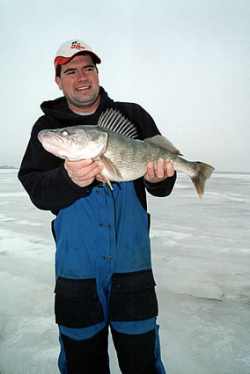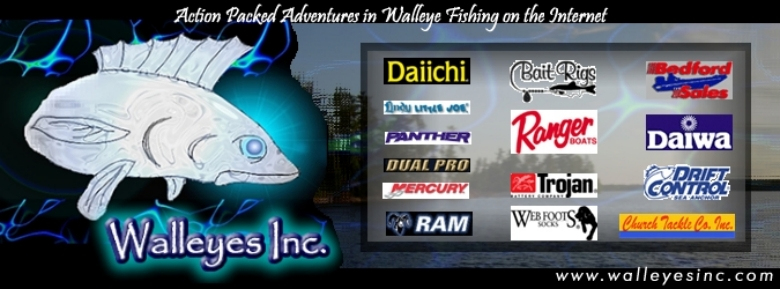Fish spook from angling pressure but how much so is cause
for debate. During the open water season, we catch fish four
feet under the boat quite often. That’s right below
the boat, big motor running, livewells running, transducers
vibrating…. And the fish often don’t seem to care.
There are other days where we can’t get close to fish
and either have to cast or long line bait or lures a good
distance behind the boat. Under the ice is really no different.
Vehicles and generators running usually don’t bother
the fish at all from what I have seen but too much commotion
can drive fish away in a hurry. Vehicles driving up, causing
the ice to pop, even augers drilling more holes can seem to
hamper success.
Now obviously at some point, you have to drive up to a spot
and you have to drill a hole to catch fish but where is the
tipping point? We have to make some commotion obviously to
wet a line but when is too much really too much? I don’t
have all the answers but I do know what I have seen while
using an underwater camera. There are times when fish will
scatter in thirty or more feet of water when a vehicle drives
up fast. I have also watched fish scatter after drilling more
holes. This is a constant dilemma I face while guiding. I
know that as soon as I drive away, pick up a few anglers and
get back over my hole and drill a few more holes, there is
a good chance I will blow the fish off the spot. There is
also a chance that I won’t. Which is exactly why trying
to determine what will spook fish can be so frustrating. There
are days when you can get away with a lot of commotion and
the bite beats on while there are other days where the fish
spook if you let the lure drop too fast.
 |
With walleye fishing in particular, the
bite is usually over by the time a good crowd gathers.
By the time everybody knows about a bite, the bite is
history. Now good spots can fire up again as anglers clear
out of a spot and things quiet down but in all my years
of ice fishing, I have never seen a spot get better as
the mob gathers. This is why the best walleye anglers
on the ice don’t talk. Unless you know somebody
very well, people will usually never tell you where they
are "catching" fish, they dodge the bullet by
telling you where they "caught" fish. The simple
truth is that if you talk or can’t contain your
excitement at the local baitshop or watering hole, you
are going to have company on your spot the next night.
Now company isn’t bad and neither is sharing information
since nobody owns the lake but you best be prepared to
find another spot soon because your hot hole will soon
be cold. A mob of vehicles and houses will do more to
curtail the bite than any cold front. |
Using GPS, Maps and the "Off Season"
The key to catching walleye through the ice for me is staying
one step ahead of the masses. A good depth of spots to check
and knowledge of the lake is certainly beneficial but with
the lake maps and GPS mapping capabilities we have today,
any angler can go to a lake sight unseen and fish good spots
that haven’t been beaten to death. There will come a
time when savvy anglers will focus on finding humps, saddles
and other walleye tidbits of structure that don’t appear
on any map chip as more and more anglers use GPS on the ice.
This time is real soon or already here on many lakes that
receive serious fishing pressure. On many of the lakes I fish,
primarily Devils Lake in North Dakota… many anglers
are still trying to find prime structure the hard way. A GPS
with a good map chip of the lake you are fishing is becoming
crucial. I would rate my GPS as an almost essential tool,
right up there with my Vexilar and auger.
Many of my favorite spots that aren’t obvious on a
map chip are usually discovered and saved months before during
the open water period. I don’t do a lot of traveling
to fish and am fortunate enough to be able to make my living
fishing one lake where I get to go home every night and sleep
in my own bed. Thus I get to spend all summer scoping out
spots that might be good once the lake freezes.
If you don’t have this luxury, you can still find spots
off the beaten path by really scrutinizing existing lake maps
for minor variances that may yield a whole lot more when actually
on the water. Many of the better spots I can think of might
not look like much on any map but the maps do hint at their
presence by indicating something. A map for example might
hint of a nice inside turn that cuts up close to shore along
a shoreline that doesn’t look all that special. On the
water investigation might reveal that the inside turn cuts
through a gradually sloping sand flat that has nice shoots
of still green coontail. Out from the inside turn before the
bottom drops into the lake basin, the bottom actually comes
up a foot as the hard mud bottom on the break turns into rock
the size of your fist. This spot might be the honey hole.
Some years it is, some years it isn’t but just remember
that many of the best spots aren’t the most obvious
on lake maps or GPS mapping chips. Learning how to scrutinize
maps is important. No matter how much I fish a body of water,
I am still learning new spots and still looking at maps.
Maximizing the Middle of the Day
There are other ways to obtain crucial information on water
that you travel to or don’t get to spend the summer
on. During the daylight hours when the sun is high, the bite
for walleye notoriously falls off. This might not be a great
time for actually fishing but the combination of clear water
and a high sun make viewing with an underwater camera extremely
effective. With an underwater camera, you can view pieces
of the lake bottom and put together a good mental picture
as to what lies below. You can see where the rocks start for
example. You can actually see the structure you are fishing
and imagine what dips and troughs walleye will slide through
a few hours ahead when the sun starts to set. Knowing what
the lake bottom actually looks like is sometimes surprising
yet invaluable information. I am not big on using cameras
while I am actually fishing when the target is walleye. Because
most of my best fishing is during the low light hours of the
day and because I don’t like taking the chance of a
real nice fish wrapping around the cord. I still prefer relying
on my Vexilar as my underwater eyes when I am actually trying
to catch fish. That is not to say however that an underwater
camera is an invaluable tool for learning how to become a
more astute angler.
Often, patterns emerge that revolve around bottom composition.
There are times when if you find softball size rocks in 20
to 30 feet of water, you find walleye. Other times where if
you find gravel or sand along shorelines that are mostly hard
mud with dense weed growth, these openings where the bottom
is a different substrate hold fish. The possibilities are
endless but you get the picture. When something is working,
a camera can enable you to repeat the pattern elsewhere with
more precision.
The Prime Time Hustle
On many lakes, including the lake I spend most of my time
on, success for walleye hinges on sunrise and sunset. This
prime time period is when most of the fish move up across
points, saddles, humps or along shorelines and want to eat…
most of the time. There are always exceptions. This prime
time is often intense where you will have most of your opportunities
squeezed into a narrow window of time. If there is a time
to hustle while you are trying to catch walleye through the
ice, this is the time. From my time on the water, I have found
one simple thing that has increased my catch dramatically
and is rather simple… rebait often. When fish come in
and won’t hit what I have down, I can often pinch off
a new minnow head and get the bait back down in the water
much faster than I could actually change the lure itself.
How walleye respond to a fresh minnow head is surprising,
often responding better to the fresh bait better than if I
would have changed lures. That is not to say changing lures
isn’t important because it is until you find the "working
lure" but adding new meat is as important or more important.
If given the choice between switching lures, size, colors,
etc.. I would rather get a new and fresh minnow head on the
hook and get that piece of meat in front of the fish while
it is still below me. During prime time, I will often rebait
my hook every five minutes. There is just something about
a freshly pinched minnow and I imagine scent plays a big role.
I seldom use a whole minnow while I am jigging and prefer
to use the head, pinch the minnow in half or even pinch off
the tail.
Of all the things you can do this winter to catch more walleye,
the baiting factor is often overlooked. Many people change
their minnow when they loose the minnow. There are people
who will use the same minnow head all night. When the fish
are hot, the old minnow works great but nothing triggers turned
off fish like a still bleeding minnow head that was just pinched
off at the air sack. Juices flowing, intestines dancing, you
get the picture. I dare say that many anglers can double the
fish they catch by merely getting into the routine of keeping
fresh bait on their hooks.
Editors Note: The author Jason Mitchell is a member of Devils
Lake’s Perch Patrol Guide Service, (701) 351-3474 and
rents deluxe sleeper houses on Devils Lake, (701) 351-1890.
Lodging provided by Woodland Resort, 701-662-5996.
|

